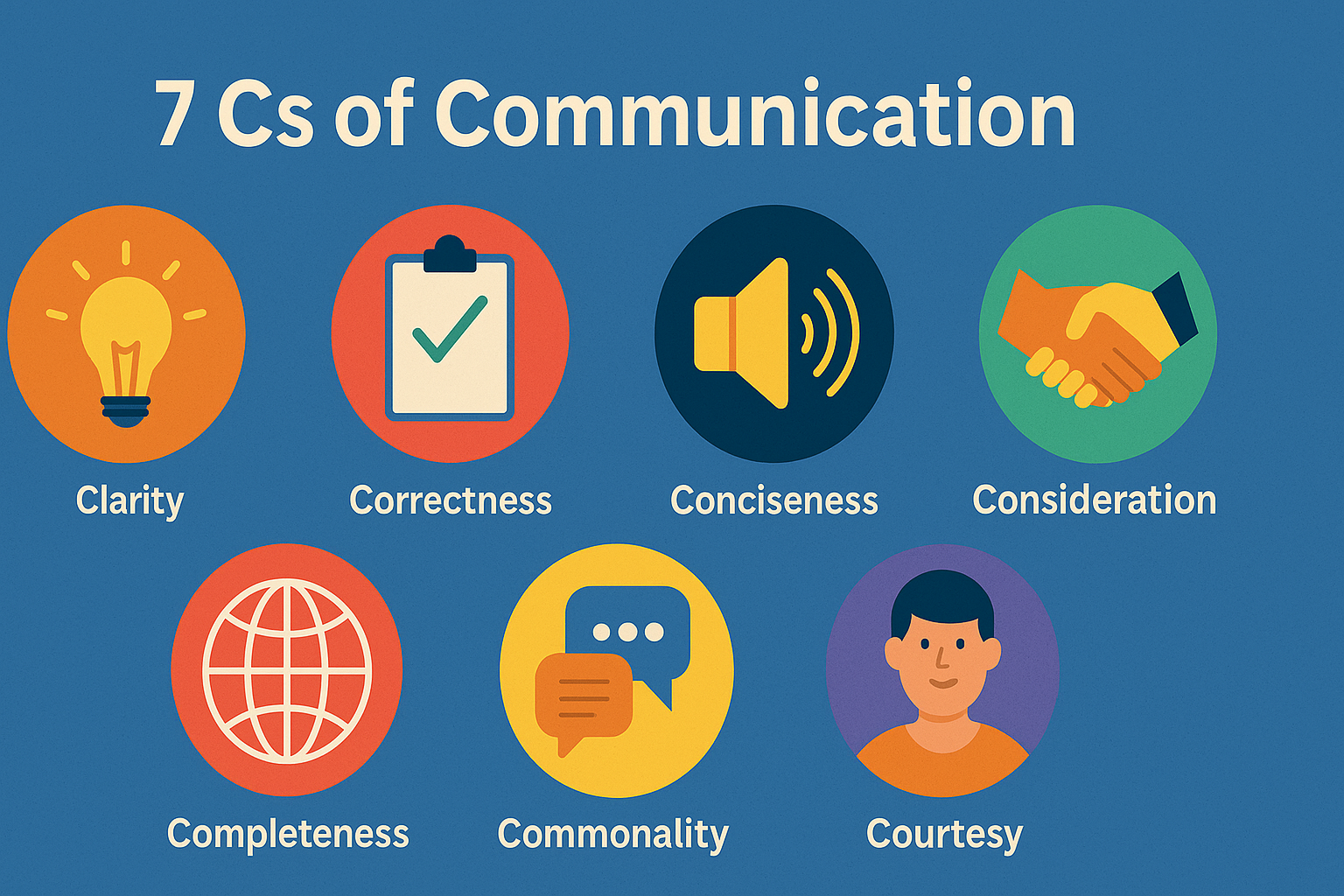Communication is a bridge — and like any bridge, it needs strong pillars to hold it up. That’s exactly what the 7 Cs of Communication do. They provide a checklist to ensure that every message you send is clear, complete, and effective — whether you’re writing an email, giving a presentation, or just chatting with a friend.
In this blog, we’ll break down each C in the simplest way possible, with easy examples you can start using today!
Contents
What Are the 7 Cs of Communication?
The 7 Cs of Communication are a set of principles to make your message impactful and audience-friendly. These are:
- Clarity
- Correctness
- Conciseness
- Consideration
- Completeness
- Commonality
- Courtesy
Let’s decode each of them below.
1. ✅ Clarity: Be Crystal Clear
What it means: Your message should be easily understood by the receiver. Use simple words and focus on one idea at a time.
Example:
❌ “We’re aiming for strategic objectives.”
✅ “We want to increase customer satisfaction.”
💡 Tip: Think of clarity as turning foggy glass into a clean window — the message must shine through.
2. ✅ Correctness: Be Accurate
What it means: Always use the correct facts, names, numbers, and grammar. Inaccurate messages damage trust.
Example:
❌ “The event is on 26th Feb, Wednesday.” (Wrong date-day match)
✅ “The event is on Wednesday, 26th February 2025.”
💡 Tip: Proofread twice. If it’s a fact, verify it.
3. ✅ Conciseness: Be Brief but Powerful
What it means: Don’t beat around the bush. Say what’s necessary — and nothing more.
Example:
❌ “I just wanted to maybe discuss this if you’re okay with it…”
✅ “Let’s discuss this.”
💡 Tip: Remove fillers like “just,” “maybe,” “sort of.”
4. ✅ Consideration: Think About Your Audience
What it means: Put yourself in the receiver’s shoes. Use language, tone, and examples that matter to them.
Example:
If you’re talking to a student, avoid corporate jargon. Instead, connect with student experiences or relatable examples.
💡 Tip: Always ask: “How would they understand this?”
5. ✅ Completeness: Leave No Gaps
What it means: Share all the necessary details so the receiver doesn’t need to guess or ask follow-up questions.
Example:
❌ “Let’s meet tomorrow.”
✅ “Let’s meet tomorrow at 10 AM in the conference room.”
💡 Tip: Use the 5Ws — Who, What, When, Where, Why.
6. ✅ Commonality: Find Common Ground
What it means: Use shared language, culture, or interests to connect. Without commonality, communication can break down.
Example:
A sports analogy may not work for someone uninterested in sports. Instead, find something both parties relate to.
💡 Tip: Understand your audience’s background or interests before communicating.
7. ✅ Courtesy: Be Respectful
What it means: Use polite language and a respectful tone, even when giving feedback or disagreeing.
Example:
❌ “You didn’t follow instructions.”
✅ “Let’s review the instructions again together.”
💡 Tip: Respect earns attention. Harshness shuts doors.
📌 How to Apply the 7 Cs in Daily Life?
| Scenario | How to Use the 7 Cs |
|---|---|
| Emails | Clear subject line, concise body, polite tone |
| Meetings | Coherent structure, complete agenda, respect everyone’s time |
| Presentations | Concrete facts, simple visuals, speak clearly |
| Chats & Conversations | Listen actively, avoid vague words, be kind |
Quick Checklist: Practice the 7 Cs Every Day
✔️ Did I focus on one idea?
✔️ Are my facts and grammar correct?
✔️ Did I avoid repetition?
✔️ Did I consider my audience?
✔️ Is all important info included?
✔️ Am I using shared language or references?
✔️ Did I sound respectful and professional?
Conclusion: Why the 7 Cs Matter?
Whether you’re a student, teacher, or working professional, communication is your superpower. The 7 Cs of Communication are timeless tools that help you connect better, influence smarter, and express clearly. Master these, and your words will work for you !
🔗 Ready to Dive Deeper?
👉Explore all our blog articles on Communication and Media Studies made simple.




7 pillars of communication! Very informative article. Thank you 🙂
Very informative article!